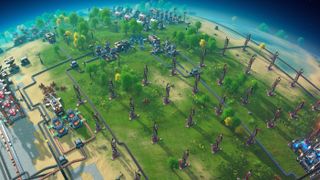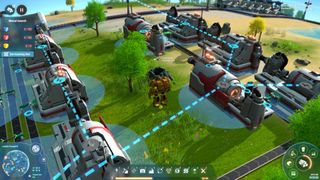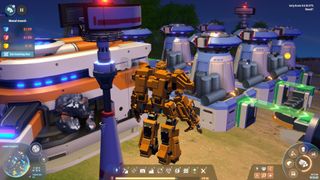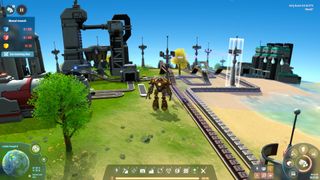
Looking for the best ways to generate power in Dyson Sphere Program? Building a Dyson Sphere requires a huge amount of energy, which is somewhat ironic given the whole point of a Dyson Sphere is to utilise a star as a renewable energy source.
Anyway, this guide will take you through everything you need to know about generating power in Dyson Sphere Program, from the types of generators available, to the various kinds of fuel, as well as tips on how to get the most out of your energy grid.
Dyson Sphere Program power generation: the different types
There are multiple ways to generate power in Dyson Sphere Program. Each has its advantages and disadvantages, which can vary depending on what stage you’re at in the game, and your particular circumstances:
Wind Turbines
Simple to construct and install, wind turbines are a quick and easy solution to power generation, easily supplying your energy needs for the first few hours of the game. However, the amount of power generated per turbine is relatively low (300 kilowatts per turbine), so you’ll need to regularly expand your wind farm to maintain your energy requirements. Coupled with the fact that turbines must be placed a set distance from one another, wind farms will quickly eat up planetary space, which will eventually become a problem when your factory hits a certain size.
Thermal Power Station
Producing more power in a smaller space than wind turbines (2.16 megawatts per power station) Dyson Sphere Program's thermal power stations will likely form the core of your energy grid for a large portion of the game. The main downsides to thermal power stations are that they’re more complex to build than wind turbines, and they require fuel to produce power. That said, establishing an assembly line for thermal power stations is hardly the most complex task you’ll do in the game. And while they do require fuel, virtually anything flammable can be thrown into them, from wood to coal to oil and beyond.
Solar Panel
Like wind turbines, solar panels are a renewable energy source, so they don’t require occasional maintenance like thermal power stations do. At 360 kilowatts per panel, they generate slightly more power than turbines. But they only work at night, and so require either additional power generation or batteries for consistent power supply.
Mini Fusion Power Station
Mini fusion power stations function similarly to thermal power stations, but are much more powerful. They’re also more specific about what goes into them, whereas thermal power stations are basically giant incinerators you can toss almost anything into, mini fusion power stations only accept one fuel type: Deuterium Fuel Rods. Deuterium must be manufactured by inserting hydrogen into a fractionator. It’s a more complex process than using thermal stations, but it’s worth doing in the later game when you need huge amounts of power.
The biggest gaming news, reviews and hardware deals
Keep up to date with the most important stories and the best deals, as picked by the PC Gamer team.

Ray Receivers and Antimatter Star
As you reach the mid to late game, you’ll gain the ability to draw power from the Dyson Sphere itself, in the form of Ray Receivers that surround your chosen star. You’ll also gain the ability to build your own artificial star. Building these is as much an objective of the game as they are practical infrastructure, so you won’t need to worry about them for quite a while.
Dyson Sphere Program fuel: the different types
There are many types of fuel in Dyson Sphere Program, from the humble log all the way up to the obscenely powerful antimatter fuel rod. Each fuel type outputs a different amount of energy when burned, with some being more efficient than others.
I've listed them all below, although you probably won’t use most of these as fuel on a regular basis. At the start of the game, the best fuel to burn in your power stations is coal. That is, until you research Energetic Graphite, which can be produced by inserting two coal into a smelter, outputting more overall energy when burned than two individual chunks of coal.
| Type | Energy | Fuel Chamber Generation Value (FGC) |
|---|---|---|
| Plant Fuel | 500 kJ | -30% |
| Log | 1.5 MJ | -10% |
| Organic Crystal | 1.8 MJ | -20% |
| Coal | 2.7 MJ | 0% |
| Energetic Graphite | 6.3 MJ | +60% |
| Crude Oil | 4MJ | +20% |
| Refined Oil | 4.4 MJ | +30% |
| Hydrogen | 8 MJ | +100% |
| Deuterium | 8 MJ | +100% |
| Diamond | 900 kJ | -50% |
| Graphene | 96 kJ | -70% |
| Carbon Nanotube | 84 kJ | -80% |
| Fire Ice | 4.8 MJ | +40% |
| Hydrogen Fuel Rod | 40 MJ | +200% |
| Deuterium Fuel Rod | 600 MJ | +300% |
| Antimatter Fuel Rod | 7.5 GJ | +500% |
| Full Accumulator | 90 MJ | +100% |
Dyson Sphere Program hydrogen: How to get unlimited fuel
While fuel sources like coal and wood are abundant, they are ultimately finite and will, eventually, run out. The exception to this is hydrogen, which can be produced in limitless quantities. Hydrogen is produced by cracking crude oil, and crude oil is not limited to a set number of units in the game. It’s only limit is the speed it can be pumped out of the ground. You can burn crude oil as a fuel source, too, but hydrogen is far more energy efficient.
To create hydrogen, first you need to pump crude oil from the ground with an oil extractor, then run it through an oil refinery. This will produce a small amount of hydrogen alongside a large amount of refined oil. To up the hydrogen production, run both the refined oil and hydrogen through a second refinery, this time with the refining process of X-Ray Cracking. This will produce three hydrogen for every one inserted, along with the by-product of Energetic Graphite, another handy fuel source.
Then, using either a belt splitter or belt sorters, you can feed some of the newly produced hydrogen back into the X-Ray Cracking Oil Refineries, creating an exponential hydrogen feedback loop. You will need a method to either use or store all of this hydrogen, however, else you’ll soon clog up the belts and the whole operation will come to a standstill.

How to keep your mech fuelled
A small and, frankly, annoying feature of Dyson Sphere Program is that you have to regularly fuel your mech so you can move, fly, and build. To do this, click on the 'Mecha' button in the lower-right corner of the screen. This will bring up a box showing details of your mech. Then, click and drag any fuel item from your inventory into the Fuel Chamber in the top-right corner of the box.
As for what to fuel your mech with, Energetic Graphite will keep you going the longest. Hydrogen is technically more efficient per unit, but only stacks up to 20. Energetic Graphite, by comparison, stacks up to 100. Note that fuelling your mech is not the same as charging it, another eccentric feature of Dyson Sphere Project I’ll discuss shortly.

Ensure your power is distributed effectively
Just as having all power in the hands of one person is a terrible idea, having all your power in one place is no good either. Ensure your energy is being distributed effectively so your factory can, well, make things.
At the outset, distributing power is done using Tesla Towers, which are basically fancy electricity pylons. Plant one within range of a machine that needs energy, and provided the Tesla Tower is connected to others on the grid, that machine will spool up quicker than Doom’s chaingun.
Power can also be distributed through Wireless Power Transmission. These neon-blue towers have a smaller distribution range than Tesla Towers, but have the advantage of charging you mech whenever you stand under them. As well as requiring fuel, your mech’s batteries have a set charge level that limits your ability to fly and even build. Hence having regular recharge points lets you crack on with whatever job you’re doing uninterrupted.
In the later game, you can distribute power on an interplanetary scale using Energy Accumulators. These giant, conical batteries can store huge amounts of power, which can then be shipped off to another planet and extracted at the desired location.
Another thing to know about optimising power generation in Dyson Sphere Program
By clicking the 'Details Display' button in the lower-right corner of the screen, you can activate several overlays that provide information about your factory. One of these highlights your energy grid, showing you the full distribution of power across your factory. If those highlights are all coloured blue, you’ve got energy to spare. If they turn or blink orange, you need to increase your power output.
Most Popular

